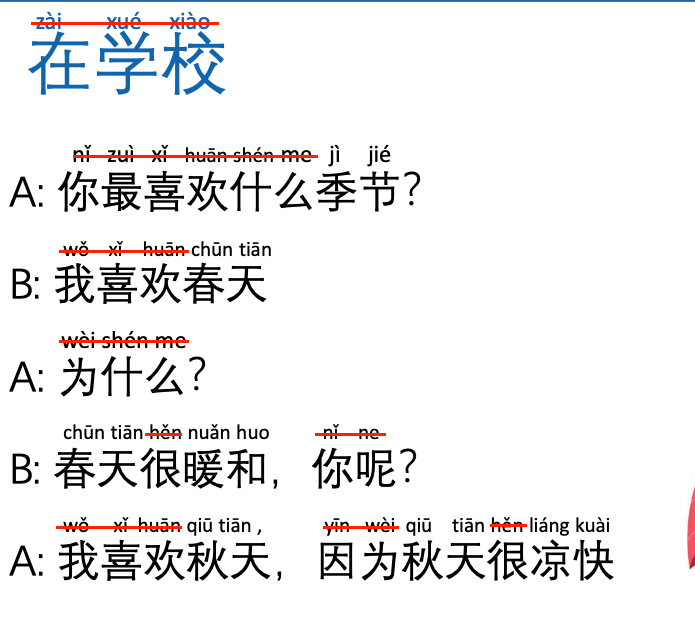Hello.
We love to hear your voice. We currently have some thoughts about Pinyin.
1 . Where should Pinyin are displayed? below or above CHinese character
2. Until which level do you not want to see Pinyin anymore?
Please let us know in the comment below.
1 Like
Neither below, nor above. Personally I’d rather see it off to the side or at the bottom of the page somewhere, where it can be referenced only when needed. And definitely for hsk4 and up should not have pinyin except for key words or words most students might not know - but again, away from the text. Pinyin is a crippling crutch.
3 Likes
I think thats an imortant point - different requirements for different levels.
1 Like
My opinion is that at lower levels (1-2) pinyin should be always there but maybe starting at 3 or 3+, pinyin should be only on top/below the new characters and words for that level, not on anything that’s from a lower one. Foreign transliterations or things/people’s names should have pinyin too, since most of them are outside HSK. Maybe using the HSK levels as reference and not the previous LTL lessons, since we see many words that are of higher levels or outside HSK and those are harder to remember than the basic HSK1-2 characters.
An example from an LTL HSK3 lesson. Left some characters learned from previous levels that are parts of the new words, like 节,天,和 and 快.

5 Likes
I would be happy with any kind of reducing pinyin.
I usually try to cover the pinyin somehow when I am reading and working through the text.
I just checked a random HSK3 lesson. There were only two new words for me, that get explained anyway, and one extra character. So, for me, I think HSK3 can be without pinyin.
Of course I would be very happy with a sort of solution footnote: less preparation needed and one could reassure oneself quickly. Btw I study with a German-Chinese book series that is really hard-core. No pinyin at all from the beginning, only for new words. But the result is, that I didn’t work as much with the book as I should or could have. As I have improved a lot I have fun rereading everything now, without any pinyin.
I want to suggest that some singular slides could be without pinyin already in HSK 1 and 2. As a hint for the future way of reading.
2 Likes
I have never thought of having pinyin below the characters. This would be nice indeed. When you scroll, you could always easily hide the pinyin. Good idea, Rosie 
4 Likes
Hi. Maybe I am an exception, but I do not plan to learn Chinese characters. I am learning Mandarin purely for recreational purposes and don’t want to put in the immense effort I fear it would be to learn characters.
But I do want to reach a conversational level of Mandarin. I am in HSK 2 now. If pinyin gets faded out, I would no longer be able to attend courses. Maybe there can be the option of choosing which slide (pinyin or non-pinyin) you would like to use before class starts?
2 Likes
Makes total sense! We already have 2-3 versions per city of many lessons, maybe just add one more version with all pinyin (and remove it from the others) or one version without the pinyin (and leave it on the others).
4 Likes
Hiya Rosie, I would personally think after HSK 3 there should be pinyin to the side.
I learn traditional characters but am HSK4 so with LTL classes in simplified, there are quite a lot of differences or things I’d otherwise be unsure on.
If there was traditional versions of slides then I don’t mind not having pinyin at all
3 Likes
cool. I learn traditional CHinese too. It’s great to know that you can read both simplified and traditional. I have the same thought with you as well
1 Like
make sense. for lower level, we will keep pinyin there. We plan to remove some pinyin in HSk3+ and HSK4. Thanks for your nice suggestion
1 Like
sound great. I agree with you on the point of keeping pinyin for new words and Foreign transliterations. it makes sense.
As an experiment, I took one set of slides and changed the color of the pinyin to something barely readable, mostly a very dim light gray. That helped focussing on Hanzi effortless, while still being able to find the pinyin if needed, by taking a closer look. That worked quite well.
3 Likes
Interesting. Could you share?

I don’t know how to upload ppts here, so I am posting an example page. I admit that the ppt was created under violation of the “DO NOT MODIFY, EDIT, OR CHANGE THIS PDF” rule, but it was only for myself. The process was tedious, because I don’t have the skills to change pdfs directly, so I had to use some online tool to convert it into a ppt.
When I look at the screenshot now at full daylight I see that the gray is almost too weak to read the pinyin. When I created the ppt originally it was dark around me, and the gray letters were more readable.
2 Likes


